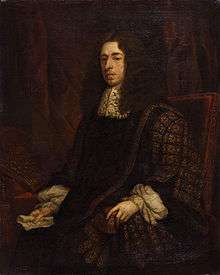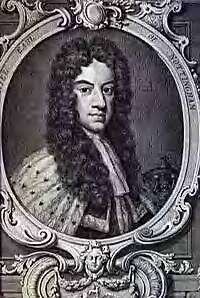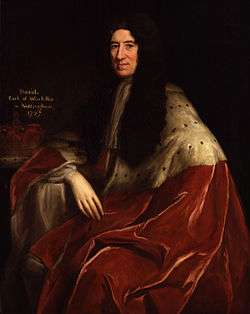Daniel Finch, 2nd Earl of Nottingham
Daniel Finch, 2nd Earl of Nottingham, 7th Earl of Winchilsea PC (2 July 1647 – 1 January 1730), was an English Tory statesman during the late seventeenth and early eighteenth centuries.
Early life

Daniel Finch was born on 2 July 1647 and was the son of Heneage Finch (later the first earl of Nottingham and Lord Chancellor of England) and Elizabeth Harvey, daughter of Daniel Harvey.[1] Little is known about his upbringing. He entered the Inner Temple and Westminster School in 1658, where he boarded for three years at the house of Dr. Richard Busby, the headmaster and his father's tutor at Christ Church, Oxford. Finch went to Christ Church too and the excellence of his studies made his father doubt their authenticity. He matriculated at Christ Church as a Gentleman Commoner on 26 July 1662.[2] In April 1663 his father wrote to him, advising that he "loose not the reputation which I am told you have gayn'd of diligence and sobriety".[3]
His father also advised him a month after he had arrived in Oxford "to frequent the publique prayers, and study to reverence and defend, as well as to obey, the Church of England" and when his first Easter away from home was approaching, he wrote, "Nothing can make you truly wise but such a religion as dwells upon your heart and governs your whole life". However Finch suffered from illness and it may be due to this that he left Oxford without graduating.[4]
Finch went on his Grand Tour from 1665 to 1668, visiting Frankfurt, Munich, Venice, Florence, Naples, Rome, and Paris.[5] After he returned to England he was appointed a Fellow of the Royal Society and his cousin Sir Roger Twysden wrote to Finch's father that "every body speaks him a very gentleman, and one you and your lady are likely to have much comfort in".[6]
Political career

Daniel Finch entered parliament for Lichfield in 1679. He was one of the privy councillors who in 1685 signed the order for the proclamation of the Duke of York, but during the whole of the reign of James II, he kept away from the court. At the last moment, he hesitated to join in the invitation to William of Orange, and after the flight of James II he was the leader of the party who were in favour of James being King in name and William being regent.
He declined the office of Lord Chancellor under William and Mary, but accepted that of secretary of state, retaining it until December 1693. Under Anne in 1702, he again accepted the same office in the ministry of Lord Godolphin, but finally retired in 1704.
In 1711, during the War of the Spanish Succession, the Tory ministry of Robert Harley, 1st Earl of Oxford, was attempting to negotiate peace with France. On 7 December Finch moved the 'No peace without Spain' amendment to the vote of thanks, which condemned any peace with France that left Spain and the West Indies in possession of a member of the House of Bourbon. Finch spoke for one hour, in which he declared that "though he had fourteen children, he would submit to live upon five hundred pounds a year, rather than consent to those dark and unknown conditions of peace".[7]
On the accession of George I, he was made Lord President of the Council, but in 1716 he finally withdrew from office. He succeeded to the Earldom of Winchilsea (with which the Nottingham title now became united) on 9 September 1729 and died on 1 January 1730.
Marriages and children
_Finch%2C_by_studio_of_Peter_Lely.jpg)
Finch first married on 16 June 1674 Lady Essex Rich,[8] a daughter of Robert Rich, 3rd Earl of Warwick and Anne Cheeke. Lady Essex bore her husband 8 children but only one daughter survived to adulthood: Mary Finch (born 1677) later married to John Ker, 1st Duke of Roxburghe.[9] Mary was also a lover of William Savile, 2nd Marquess of Halifax, and later married him, following the death of his first wife Elizabeth Grimston.

Finch's second marriage, on 29 December 1685, was to Anne Hatton (1668–1743), daughter of Christopher Hatton, Viscount Hatton. Lady Nottingham was appointed a Lady of the Bedchamber to Queen Mary II in 1691. She had over twenty pregnancies.[10]
The couple had at least twelve surviving children:
- Daniel Finch, 8th Earl of Winchilsea (24 May 1689 – 2 August 1769). He was first married to Lady Frances Feilding, daughter of Basil Feilding, 4th Earl of Denbigh and Hester Firebrace. He was secondly married to Mary Palmer, daughter of Sir Thomas Palmer, 1st Baronet Palmer. No known descendants.
- William Finch (1690 – 25 December 1766). He married Charlotte Fermor, daughter of Thomas Fermor, 1st Earl of Pomfret. They were parents of Sophia Finch and her younger brother George Finch, 9th Earl of Winchilsea.
- John Finch (1692–1763), who left a daughter.
- Hon. Henry Finch (1694 – 26 April 1761),[11] whose illegitimate daughter, Charlotte (d. 5 April 1810), married Thomas Raikes, Governor of the Bank of England
- Edward Finch (MP) (1697 – 16 May 1771). He was married to Elizabeth Palmer, another daughter of Thomas Palmer, 1st Baronet Palmer. They had three children. He later took the surname Finch-Hatton, and was the grandfather of George Finch-Hatton, 10th Earl of Winchilsea.
- Essex Finch (29 Feb 1687 – 23 May 1721). She was married to Sir Roger Mostyn, 3rd Baronet of Mostyn in 1703. They were parents to Sir Thomas Mostyn, 4th Baronet of Mostyn and two other children.
- Lady Charlotte Finch (1693 (?1711) – 21 January 1773). In 1725 she became the second wife of Charles Seymour, 6th Duke of Somerset. They were parents to Lady Charlotte Seymour and Lady Frances Seymour.
- Lady (Cecilia) Isabella Finch (1700–1771), who never married but became first Lady of the Bedchamber to Princess Amelia, a spinster aunt of King George III.[12] In 1740[13] she commissioned William Kent to build her a magnificent town house at 44 Berkeley Square in Mayfair, London, which is famed for its theatrical staircase. It was purchased after her death by William Henry Fortescue, 1st Earl of Clermont (1722–1806), and served as his London townhouse. In the 20th century it was used as the Clermont Club.[14]
- Mary Finch (1701 – 30 May 1761). Not to be confused with her elder half-sister. She was married to Thomas Watson-Wentworth, 1st Marquess of Rockingham in 1716.
- Lady Henrietta Finch (1702 – 14 April 1742). In 1723, she married William Fitzroy, 3rd Duke of Cleveland, a son of Charles Fitzroy, 2nd Duke of Cleveland and Anne Poultney. No known descendants.
- Elizabeth Finch (1704 – 10 April 1784). She married William Murray, 1st Earl of Mansfield. No known descendants.
Legacy

The Whig historian Lord Macaulay said of Lord Nottingham in 1848:
| “ | This son, Earl Daniel, was an honourable and virtuous man. Though enslaved by some absurd prejudices, and though liable to strange fits of caprice, he cannot be accused of having deviated from the path of right in search either of unlawful gain or of unlawful pleasure. Like his father he was a distinguished speaker, impressive, but prolix, and too monotonously solemn. The person of the orator was in perfect harmony with his oratory. His attitude was rigidly erect: his complexion so dark that he might have passed for a native of a warmer climate than ours; and his harsh features were composed to an expression resembling that of a chief mourner at a funeral. It was commonly said that he looked rather like a Spanish grandee than like an English gentleman. The nicknames of Dismal, Don Dismallo, and Don Diego, were fastened on him by jesters, and are not yet forgotten. He had paid much attention to the science by which his family had been raised to greatness, and was, for a man born to rank and wealth, wonderfully well read in the laws of his country. He was a devoted son of the Church, and showed his respect for her in two ways not usual among those Lords who in his time boasted that they were her especial friends, by writing tracts in defence of her dogmas, and by shaping his private life according to her precepts. Like other zealous churchmen, he had, till recently, been a strenuous supporter of monarchical authority. But to the policy which had been pursued since the suppression of the Western insurrection he was bitterly hostile, and not the less so because his younger brother Heneage had been turned out of the office of Solicitor General for refusing to defend the King's dispensing power.[15] | ” |
Notes
- ↑ Henry Horwitz, Revolution Politicks. The Career of Daniel Finch, Second Earl of Nottingham, 1647–1730 (Cambridge: Cambridge University Press, 1968), p. 2.
- ↑ Horwitz, p. 2–3.
- ↑ Horwitz, p. 3.
- ↑ Horwitz, p. 4.
- ↑ Horwitz, p. 4–5.
- ↑ Horwitz, p. 6.
- ↑ Horwitz, p. 232.
- ↑ ODNB, "Daniel Finch"
- ↑ Burke's Peerage (1939), s.v. Roxburghe.
- ↑ "TWO AUTOGRAPH LETTERS SIGNED ("MARIE R"), TO ANNE, COUNTESS OF NOTTINGHAM,". Sothebys.
- ↑ http://www.historyofparliamentonline.org/volume/1715-1754/member/finch-hon-henry-1694-1761
- ↑ Kinross, Lord
- ↑ Kinross, Lord
- ↑ 44 Berkeley Square, A Commentary by Lord Kinross Illustrated by Adrian Daintrey, London, 1962
- ↑ Thomas Babington Macaulay, The History of England from the Accession of James the Second. Popular Edition in Two Volumes. Volume I (London: Longmans, 1889), p. 449.
References
- Henry Horwitz, Revolution Politicks. The Career of Daniel Finch, Second Earl of Nottingham, 1647–1730 (Cambridge: Cambridge University Press, 1968).
- Henry Horwitz, ‘Finch, Daniel, second earl of Nottingham and seventh earl of Winchilsea (1647–1730)’, Oxford Dictionary of National Biography, Oxford University Press, 2004; online edn, Jan 2009, accessed 30 January 2011.
- Thomas Babington Macaulay, The History of England from the Accession of James the Second. Popular Edition in Two Volumes (London: Longmans, 1889).
- Burke's Peerage (1939 edition), s.v. Winchilsea
- Pearl Finch, 'History of Burley-on-the-Hill, Rutland', Volume 1 (London: J. Bale,Sons & Danielsson Ltd, 1901)
| Wikimedia Commons has media related to Daniel Finch, 2nd Earl of Nottingham. |

.svg.png)